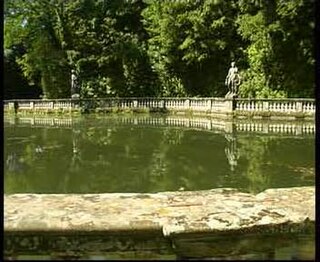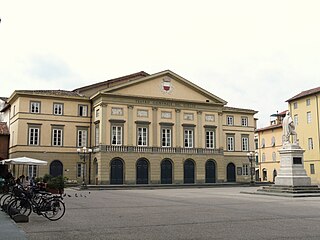
Giovanni di Nicolao Arnolfini was a merchant from Lucca, a city in Tuscany, Italy, who spent most of his life in Flanders, then part of the Duchy of Burgundy, probably always based in Bruges, a wealthy trading city and one of the main towns of the Burgundian court.
Giovanni Guidiccioni was an Italian poet.

The Province of Lucca is a province in the Tuscany region of Italy. Its capital is the city of Lucca.

Santa Cristina is a Neoclassical-style, Roman Catholic church in Pisa, region of Tuscany, Italy. It is located on the Lungarno Gambacorti.

The Italian Catholic Archdiocese of Lucca dates back as a diocese to the 1st century; it became an archdiocese in 1726. It has no suffragan dioceses, and is directly subject to the Holy See.

San Francesco is a Gothic-style, former Roman Catholic church and monastery located on piazza San Francesco in central Lucca, region of Tuscany, Italy. Since its restoration, it is now home to IMT School for Advanced Studies Lucca, a selective graduate and doctoral school.

The Ducal Palace is a palace in Lucca, Tuscany, central Italy.

Bartolomeo Guidiccioni was an Italian Roman Catholic bishop and cardinal. He was one of the closest collaborators of Cardinal Alessandro Farnese, both as Bishop of Parma and afterwards when he became Pope Paul III. He served the pope as Vicar of Rome, and Prefect of the Tribunal of the Signature of Justice, as well as a member of several ad hoc commissions of cardinals. He was Bishop of Teramo (1539–1542) and Bishop of Lucca (1546–1549). He was one of the organizers and leading officers of the Council of Trent.

Villa Mansi is a country palace and gardens located in Segromigno in Monte, near Capannori, about 12 kilometers northeast of the city of Lucca in the region of Tuscany, Italy.

The Palazzo Minerbetti is an urban palace building located on Via de Tornabuoni #3 at the corner with Via del Parione, which edges into the Piazza Santa Trinita, Florence, in central Florence, region of Tuscany, Italy.
San Romano is a deconsecrated Roman Catholic Church located on Piazza San Romano in the center of Lucca, region of Tuscany, Italy. It stands adjacent to the Ducal Palace of Lucca.

San Tommaso or San Tommaso in Pelleria is a Romanesque- style, Roman Catholic church located on Piazza of the same name in central Lucca, region of Tuscany, Italy.

The Teatro del Giglio is the historic city theater and opera house located in Piazza del Giglio #13 and #15 in the center of Lucca, region of Tuscany, Italy.
The Palazzo Bernardini is a Renaissance palace located on the Piazza Bernardini, diagonal from the church of San Benedetto in Gotella in central Lucca, region of Tuscany, Italy.
The Palazzo Cenami is a Renaissance-style palace located on Via Santa Croce in central Lucca, region of Tuscany, Italy. The palace was designed in 1530 by Nicolao Civitali. Some attribute the palace's Florentine style of architecture to Agostino Marti in 1501.
The following is a timeline of the history of the city of Lucca in the Tuscany region of Italy.
Alessandro Guidiccioni (1557–1637) was a Roman Catholic prelate who served as Bishop of Lucca (1600–1637).
Alessandro Guidiccioni was a Roman Catholic prelate who served as Bishop of Lucca (1549–1600).
Villa Mazzarosa is an early 17th-century country palace and gardens located in Segromigno in Monte, near Capannori, about 12 kilometers northeast of the city of Lucca in the region of Tuscany, Italy.












